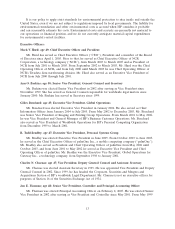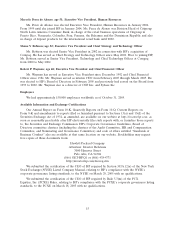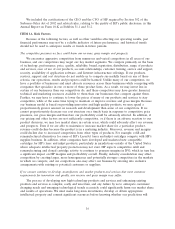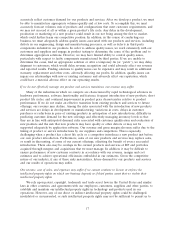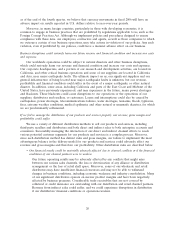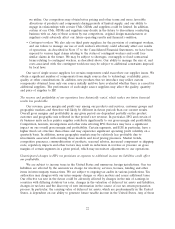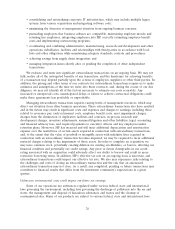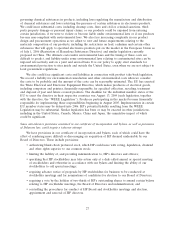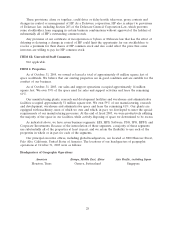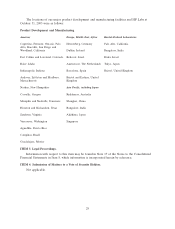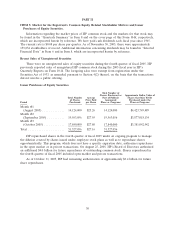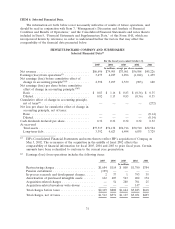HP 2005 Annual Report Download - page 27
Download and view the complete annual report
Please find page 27 of the 2005 HP annual report below. You can navigate through the pages in the report by either clicking on the pages listed below, or by using the keyword search tool below to find specific information within the annual report.changes could affect our profitability. Furthermore, our tax provisions could be adversely affected as a
result of any new interpretative accounting guidance related to accounting for uncertain tax provisions.
Our sales cycle makes planning and inventory management difficult and future financial results less
predictable.
Our quarterly sales have reflected a pattern in which a disproportionate percentage of each such
quarter’s total sales occur toward the end of such quarter. This uneven sales pattern makes prediction
of revenue, earnings and working capital for each financial period difficult, increases the risk of
unanticipated variations in quarterly results and financial condition and places pressure on our
inventory management and logistics systems. If predicted demand is substantially greater than orders,
there will be excess inventory. Alternatively, if orders substantially exceed predicted demand, we may
not be able to fulfill all of the orders received in the last few weeks of each quarter. Other
developments late in a quarter, such as a systems failure, component pricing movements or global
logistics disruptions, could adversely impact inventory levels and results of operations in a manner that
is disproportionate to the number of days in the quarter affected. In addition, we experience some
seasonal trends in the sale of our products. For example, sales to governments (particularly sales to the
United States government) are often stronger in the third calendar quarter, consumer sales are often
stronger in the fourth calendar quarter, and many customers whose fiscal and calendar years are the
same spend their remaining capital budget authorizations in the fourth calendar quarter prior to new
budget constraints in the first calendar quarter of the following year. European sales are often weaker
during the summer months. Demand during the spring and early summer also may be adversely
impacted by market anticipation of seasonal trends. Moreover, to the extent that we introduce new
products in anticipation of seasonal demand trends, our discounting of existing products may adversely
affect our gross margin prior to or shortly after such product launches. Typically, our third fiscal
quarter is our weakest and our fourth fiscal quarter our strongest. Many of the factors that create and
affect seasonal trends are beyond our control.
Any failure by us to execute planned cost reductions successfully could result in total costs and expenses that
are greater than expected.
Historically, we have undertaken restructuring plans to bring operational expenses to appropriate
levels for each of our businesses, while simultaneously implementing extensive new company-wide
expense-control programs. In July 2005, we announced workforce restructurings as well as reductions
through a U.S. early retirement program. We now expect these programs to involve the termination or
early retirement of approximately 15,300 employees worldwide through the first quarter of fiscal 2007.
We expect approximately half of the cost savings to be used to offset market forces or to be reinvested
in our businesses to strengthen HP’s competitiveness, particularly through hiring in key areas. We may
have further workforce reductions or rebalancing actions in the future. Significant risks associated with
these actions and other workforce management issues that may impair our ability to achieve anticipated
cost reductions or may otherwise harm our business include delays in implementation of anticipated
workforce reductions in highly regulated locations outside of the United States, particularly in Europe
and Asia, redundancies among restructuring programs, decreases in employee morale and the failure to
meet operational targets due to the loss of employees, particularly sales employees.
In order to be successful, we must attract, retain and motivate key employees, and failure to do so could
seriously harm us.
In order to be successful, we must attract, retain and motivate executives and other key employees,
including those in managerial, technical, sales, marketing and IT support positions. We also must keep
employees focused on HP’s strategies and goals, which may be more difficult due to uncertainty
surrounding the workforce reduction efforts announced in July 2005. Hiring and retaining qualified
23


